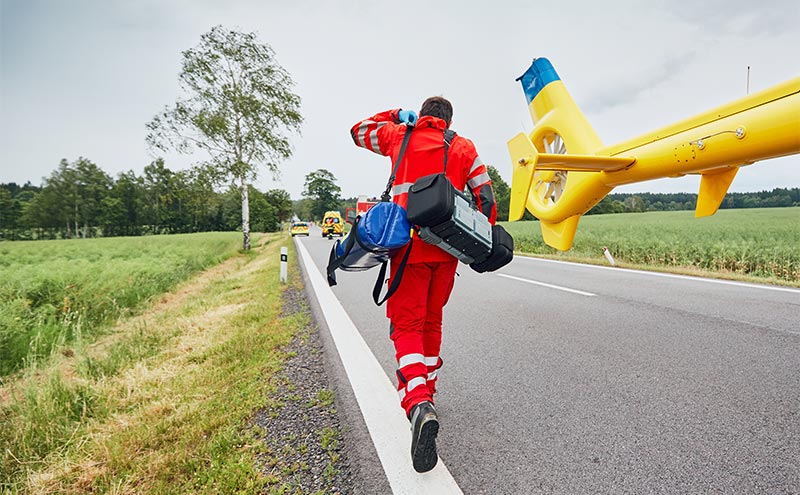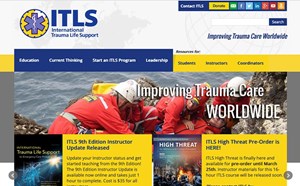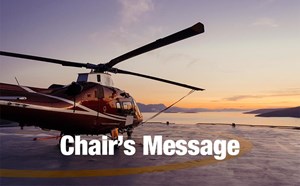
Ready, Set Go!
Che Miller, MD, is an independent practicing general surgeon on staff at Duncan Regional Hospital in Duncan, Okla. His first experience with air medicine was at the University of Oklahoma.
“We received intense trauma training, and whenever the helicopters went to refuel, and we didn’t have anything going on, we could get on board with them,” Miller said. “I thought it was so cool and that was my first exposure to air medical. I got to know a lot of those guys and hear some of their struggles and their stories.”
He’s worked in Duncan for about three years, along with another surgeon who is a farmer.
“His farm manager’s son was working at Bar S Frank meat processor in Lawton,” Miller said. “This 19 year-old was cleaning up and fell into the hot dog auger. My partner got the call.”
The young man was trapped for 90 minutes, and both of his legs were ground completely off.
“The auger pinched off the femoral artery, so he was stable enough to call his mom on the cell phone,” Miller said. “His mom works for a local hospital, so we’re very connected to the family. They got him out of there, but he died in the ambulance on the way to the hospital. If they had a surgeon on the scene to tie off the femoral artery, he may have lived.”
A year went by and during that time, Miller learned of a couple of other events, including a 40 year-old man whose wrist was smashed when a 40-ton piece of equipment fell on his hand. Miller said his head started turning and he asked, “Why can’t we go to them?”
It was from these incidents, and more, that the Surgical Extraction Team (SET) came into being. Miller began to put a plan together. The first meeting included about seven key leaders from Oklahoma State Patrol, the MERC (Medical Emergency Response Center, Duncan EMS, etc.) and other organizations. There were many unknowns, but Miller said the group knew it could be done.
“We realized we would have to draw it from the ground up,” he said. “I wrote up the protocol (15-20 pages) and how to activate it. We got together and marked it all up, and after about two more meetings, we had something. We formed a real committee. It took another two years to get most of the wrinkles ironed out.”
Miller said the biggest questions were, “Who is allowed to activate the Surgical Extraction Team?” He realized the more difficult it was to activate, the less likely it would be used.
“We estimate the cost of activation at about $30,000.00,” he said. “We created the model we think will work and will test it over the next couple of years, rather than creating a credentials rule.”
Kelly Dillon, program director for the Altus, Okla., Air Evac Lifeteam base, created a laminated card with the activation protocol and the numbers to call. Miller said the team has really pushed the concept of early activation.
“Early in the process, we’d rather be over-activated than not activated,” he said. “If we get there and we’re not needed, we’ll give you a high five and head back.”
Miller said the team was ready to go on January 1, 2016. There are currently four surgeons signed up, including one orthopedist and three general surgeons. The SET serves the southwest quadrant of Oklahoma (Region 3 Trauma).
If a call comes in, it is pinned geographically on the board and the team looks for the closest surgeon and then the closest aircraft. The air medical crew will pick up the surgeon and bring him/her to the patient. The crew will then fly the patient to definitive care.
“Air medical services have not charged for the training,” Miller said. “And they will not charge to transport the physician. That was shocking to the lay person, and we are very grateful for that.”
Miller said the SET would not have happened without Kelly Dillon’s leadership.
“She set up a bunch of meetings in rural Oklahoma, we recruited other surgeons and made them familiar with the aircraft,” he said. “One of the most successful parts of this so far has been the practice runs that we’ve done. Kelly coordinated one of those and the media came out and videotaped it.” Miller said he has long-term goals for the SET: take it to the other trauma regions in the state of Oklahoma and then take it to other states.
What Flight Crews should know if requested:
- First responders will activate the SET by calling MERC (medical emergency response center) dispatch.
- MERC dispatchers will ask a series of questions to determine if the incident meets the criteria to activate SET.
- MERC will then contact the surgeon for availability and acceptance.
- If accepted by surgeon, MERC will contact air ambulance dispatch to transport surgeon to the scene.
- Flight crew accepts request – crew must grab an X-large helmet for surgeon.
- Flight medic will be asked to ride in the stretcher and be placed prior to picking up surgeon. This will be a hot-load, therefore the flight nurse will escort surgeon to the aircraft and complete safety walk around.
- Surgeons will always be waiting at the hospital helipad with the surgeon kit (FYI – the kit weighs 31 lbs.).
- Before taking off with surgeon, pilot will complete the patient safety briefing (the ride- along waiver will always be on file with Lisa Loadholtz).
- Flight crew will escort surgeon to the scene and assist as needed.
- Surgeon will be left at the scene (unless two aircraft are available), and OHP will transport surgeon back to the destination.
- Patient transported to appropriate level of care.
Duncan, Okla., surgeon Che Miller, MD, is part of the Surgical Extraction Team. The participating surgeons go out via air ambulance when amputations are needed to save a life. Dr. Miller is pictured with Air Evac Lifeteam pilot Trevor Westermann and flight paramedic Andrew Barnthson.
Shelly Schneider
Public Relations Manager
Air Evac Lifeteam



